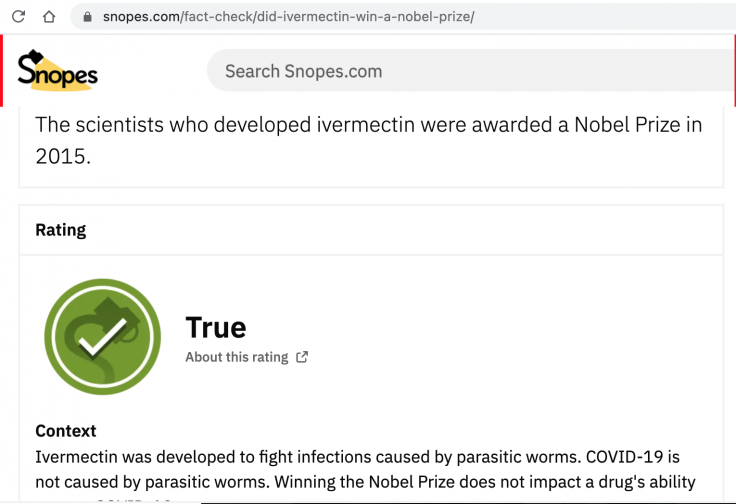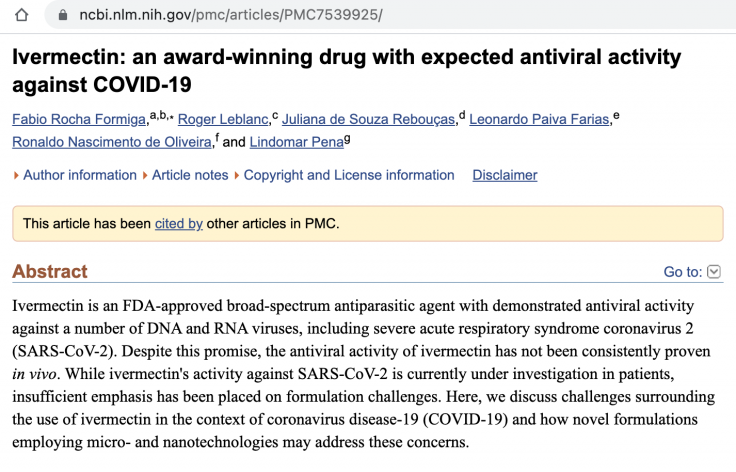|
Lazy eyes listen
|
NewsRescue
Recently Ivermectin, a drug in use on hundreds of millions of humans since 1981, has faced severe malignment from the FDA and CDC. Ivermectin received a Nobel prize for drugs in 2015.

As more experts review the drug and confirm its safety profile, the many uses of this “award-winning” “wonder drug” including its anti-Covid and anti-tumor and potential anti-MS effects among others, are coming to light.
A 2012 study by Kylie M. Wagstaff et al. found Ivermectin actually prevents HIV replication. The study concluded:
“Ivermectin inhibits infection by HIV-1 and DENV which rely on Impα/β1-mediated nuclear transport”
“Nuclear import of viral proteins is critical to the life cycle of many viruses, including many RNA viruses that replicate exclusively in the cytoplasm such as DENV, respiratory syncytial virus and rabies…”
“In summary, the results of the present study show that ivermectin is a novel inhibitor of nuclear protein import specifically mediated by Impα/β1; the nuclear accumulation of all Impα/β1-recognized cargoes tested to date can be inhibited by short treatments with ivermectin under conditions that do not lead to cytotoxicity, with no effect on nuclear import mediated by other Imps such as Impβ1 alone or Imp13. Our recent work demonstrating that ivermectin inhibits binding of Impα2 to IN and NS5 even in the absence of Impβ1 in the AlphaScreen assay (S. M. Heaton, K. M. Wagstaff and D. A. Jans, unpublished work) strongly implies that ivermectin’s mode of action is likely to be through binding to the NLS-binding pocket of Impα, thereby preventing it from recognizing NLS-containing cargo proteins, rather than alternative mechanisms such as interfering with Impα/β heterodimerization. This is in stark contrast with small-molecule nuclear import inhibitors directed at Impβ1 that prevent binding to RanGTP/cargo release [10,14], which are mostly unsuitable for live-cell work because of uptake and precipitation issues and not highly efficient in inhibiting nuclear import in all cells. Most importantly, in the present study, we have demonstrated for the first time that inhibitors of nuclear import such as ivermectin can be potent antiviral agents, able to significantly inhibit the production of HIV-1 and DENV in infected cell systems.”
See study in NCBI here: https://www.ncbi.nlm.nih.gov/pmc/articles/PMC3327999/
RELATED STUDY

Another Related Review

History of Ivermectin
What do penicillin, aspirin, and ivermectin have in common? In addition to rhyming, all three belong to the select group of drugs that can claim to have had the greatest beneficial impact on the health and well-being of humanity .
They have at least two other things in common: All three are of natural origin and all three led to a Nobel Prize . Aspirin is a derivative of salicin, a compound found in a variety of plants including willow. Although Hippocrates already speaks of its use in 400 BC, it was not isolated until 1829 as salicylic acid and was synthesized a few years later as acetylsalicylic acid. The discovery of its mechanisms of action earned Sir John Vane the Nobel Prize in 1982. Penicillin was isolated from a fungus that grew by accident in a Petri dish in Alexander Fleming’s laboratory. His discovery radically changed the course of medicine and earned Fleming the Nobel Prize in 1945, along with Howard Florey and Ernst Chain.
And this brings us to ivermectin – a drug that is probably not part of our medicine cabinet, like aspirin or penicillin, but which has certainly improved the lives of millions of people since its discovery in 1975.
The long journey of a sample of Japanese soil
The story of how ivermectin was discovered is quite incredible. In the late 1960s, Satoshi Ōmura, a microbiologist at the Kitasako Institute in Tokyo, began collecting thousands of soil samples from all over Japan, searching for antibacterial compounds. He grew bacteria from the samples, identified the cultures with medical potential, and shipped them 10,000 km away to Merck laboratories in New Jersey, where his collaborator William Campbell tested their effect against parasitic worms that affect livestock and other animals. A culture from a sample collected near a golf course south of Tokyo showed a remarkable effect against worms. The bacteria in the culture turned out to be a new species, which they named Streptomyces avermictilis.. The active compound, avermectin, was chemically modified to increase its activity and safety. The new compound, called ivermectin, was marketed for animal use in 1981 and soon became one of the best-selling veterinary drugs in the world . It is remarkable that, despite decades of searching, S. avermictilis remains the only source of avermectin that has been found.





